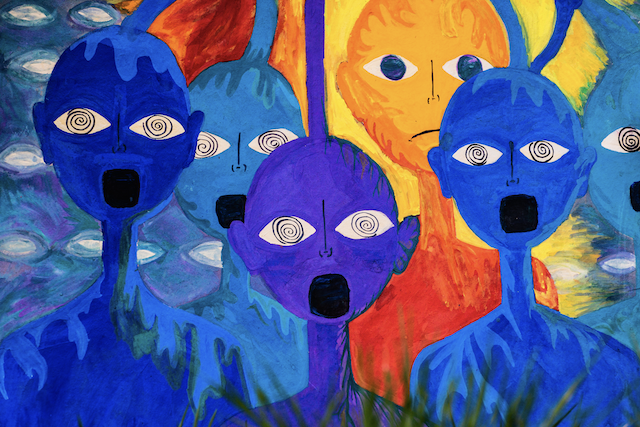
“I have never known a patient to portray their parents more negatively than they actually experienced them in childhood but always more positively–because idealization of their parents was essential for their survival.” Alice Miller, Thou Shalt Not Be Aware: Society’s Betrayal of the Child
If we’re born into dysfunctional families and, by some miracle, manage to recognize there’s something really wrong there, we can end up devoting a huge portion of our time on Earth (if not all of it) to piecemealing a life not defined by the despair and pain we felt as children.
This is as challenging a feat as it gets.
The institution of family is universally recognized as sacrosanct. But when this unquestioned bubble becomes a breeding ground for trauma, neglect, or abuse—be it covert or explicit, emotional or physical, subtle or extreme—then naming a breach, taking a stand, protecting ourselves, or even deciding to proactively heal can be seen as a betrayal.
After a lifetime of some version of this, I want to share with you seven family myths that, for years, held my healing hostage.
It was through gradually unwinding these myths one by one that I mustered the strength and resolve to go no-contact with my mother and set necessary boundaries with other members of my family, which cleared the way for a difficult but true healing process.
It hasn’t been an easy road; in fact, it’s been an almost entirely off-road journey involving enormous patience, grief, truth, and courage. But I can tell you, cross my heart, I owe it my life.
Admittedly, this is a confronting topic. We’re unpacking an aspect of being human that’s rife with open wounds, loyalty, heartbreak, and primal bonds.
My intention here isn’t to rebuff the natural ties of family but to validate your longing to feel safe, whole, and seen as you are and to shed light on the enormous potential for healing that can happen within the family structure when these myths are dismantled.
Let’s begin.
MYTH 1: Blood bonds are a free pass for bad behavior.
The pervasive refusal to address our trauma and do the work to actively heal it plays out in the family like nowhere else.
Because this is an institution that we take for granted as just and loving, it’s one in which our worst behavior can run rampant, completely exempt from checks and balances.
In these cases, the measure for love seems to be how much we’re willing to endure and how much they’re willing to endure from us. This is not okay. Family members treating each other in ways we’d be ashamed to treat virtual strangers is only the norm for one of two reasons. We’ve either taken it for granted as the only way (it isn’t), or we’re invested in not taking responsibility for healing our trauma and would rather keep open the channels to unconsciously play it out.
If the only thing binding us together is our fear of going against this institution, if the only thing that keeps us in each other’s lives is fear, guilt, shame, or the hope for a change that never materializes, and if we don’t bring these conditions to the light and question them, we sign our lives over to more of the same and enable the problem.
Refusing to play by the rule of ignoring and enduring dysfunction is the only way to end the pain chain. Repeat after me: Blood bonds are no excuse for bad behavior. Not our own, not anyone else’s.
MYTH 2: This dysfunction is what’s real and primary; well-being and sanity are fantasy and secondary.
One of the most painful parts of my experience growing up and throughout my twenties was that, despite investing more time, money, effort, and faith in my healing than I did on anything else, at the end of the day it was the energy, dynamics, and unspoken rules of the dysfunction that defined the baseline of my life.
How I wanted to live, the boundaries I was setting, and the way I was able to conduct my life were dismissed as fantasy or denial. My needs weren’t real, the relational code was. Reality was fighting, bending the truth, manipulating, worrying, speaking behind each other’s backs, enabling, blowing up, and pretending it was all okay. I was wrong and in dreamland to suggest that this wasn’t okay and that something else was possible.
Here’s what I want you to know:
You are real. And if you’re able to live without abusing others, if you’re able to take responsibility for your healing, if you’re able to create peace and harmony in your life, if you’re able to take any window of personal freedom to grow and thrive, it’s absolutely real. It can be done and it’s 100% legitimate, not to mention preferable as a way of living.
Just because your predecessors haven’t made the same choice, that doesn’t make it make-believe or a fantasy.
You make your healing and a whole new set of rules to live by true by living them out. If you’re doing it, it’s not make-believe, it’s reality.
MYTH 3: If they don’t recognize my wounds or my right to heal, I don’t get to heal.
I’ve been working on myself forever. And for a long time, while I was working on myself, I was also furiously trying to find ways to be understood and help or change my family.
I needed them to be the bridge that facilitated my healing. Only once I got them sorted or got them to understand me would I get my permission slip to live the way I was here to live. That permission slip didn’t come.
Eventually, I did the unthinkable: I gave that permission to myself.
I figured out exactly what it was that was costing my sanity, expressed it every way I could, and when it became clear that ignoring my non-negotiable needs was an implicit expectation, I said, “No more.” And in the case of my mother, I even decided to go no-contact for good. It wasn’t easy, but that began the process of healing a lifetime of parentification, erasure, and trauma.
Giving up the need to have my right to heal legitimized by family (and even friends) was the single most pivotal, empowering, and positive turning point in my life.
This shift allowed me to validate myself in the way I’d always needed. For the first time in my life, I stopped negotiating the reality of my lived experience, and in hindsight I can say without that shift, healing would not have begun.
Asserting my right to choose and protect my safety and sanity, no matter what, created the inner trust required for the magnitude of my grief and wounding to come to the forefront so I could work with what I was packing.
Healing our real wounds is a vulnerable process that requires the safety to come undone and the assurance that we won’t knowingly put ourselves back in harm’s way as we build ourselves up to wholeness.
MYTH 4: If it’s in the name of love, it’s as good as love.
When, in the name of love, we hurt, belittle, or abuse each other and demand that the flow of toxicity remains intact, we’re ultimately saying that real love doesn’t exist, or that love and truth cannot coexist.
Real love is coherent, straightforward, and present. Real love sees and honors the other as a whole, separate being with a will and truth of their own. Real love doesn’t picket someone’s right to peace, safety, and healing.
Abuse or denial in the name of love wounds, creates vortexes of remorse and resentment, and compromises our ability to recognize healthy love in ourselves and from others.
We must begin to take notice of sanctioned behaviors that are actively un-loving in the name of a love that never or rarely manifests or registers as true in the here and now.
We can all do better, and I believe, with every fiber of my being, that deep down it’s what we most long for.
MYTH 5: Whatever healing you muster is owed to the dysfunctional dynamic.
This was another big piece for me. After an abusive or painful event, the expectation was that I’d take a little break to recoup and then come back for more, rinse and repeat. This held my healing in a vice because I could never heal further than the fear of being torn to shreds again.
I knew there was a ceiling I had to break through to become the woman I knew in my heart I was, but I’d always end up at square one when I circled back to the toxic dynamics.
It wasn’t until I decided my healing was final, until I was sure I wasn’t available to siphon it back into the scheme, that my healing ceiling began to shatter and I started feeling what’s on the other side.
Repeat after me: “I’m not healing so I can be hurt again. I’m healing so I can move forward whole.”
MYTH 6: Your job is to change your NO to a YES.
This is another big one.
The truth is that most of us that have incurred substantial wounding in the family bubble have also learned to de-legitimize what’s true for us.
Because being chronically wounded (by those who gave us life, no less!) is so deeply invalidating, we come out on the other end with a wall-to-wall feeling of not being real. To them, our feelings and inner truth are getting in the way of the real us—the one they want, can do what they want with, and get what they want from without boundaries, protest, or consequence.
As a coach I see this all the time. Incredible humans with big hearts and a commitment to courageously heal that simultaneously use spirituality and self-help as a means to deny their lived experience. This allows them to avoid rocking the boat, setting boundaries, or making a real stand for their needs and truth.
“Taking the high road” seems to mean enduring breaches and abuse without hurting, feeling sated in withholding relationships, placing everybody’s needs ahead of their own, or even better, not having needs (let alone desires) at all.
I believe this is a manifestation of the same wounds of invalidation they incurred in childhood (now operating from within on the DL), combined with the unconscious belief there is no version of life that’s not subject to the rules and dynamics of their families.
Whenever I see someone bust through this myth, my heart leaps with joy because I know that’s when they’re cooking with gas.
In my personal journey, another huge turning point was when I threw in the towel of self-denial and began to notice that my NO was telling me something, and that it was up to me to listen. I could turn that NO into a YES by standing firmly in it so my life force could move toward what’s true for me.
I can guarantee that’s how it works.
How do you move into an authentic YES if someone’s trying to shove a spoonful of poison in your mouth? By saying no, trusting that no, and moving away from it.
Each and every one of us is alive and feeling regardless of the agendas and expectations of others. Your NO is not a problem; it’s a pointer to the real-deal solution for you.
Regardless of how unreal core wounding makes us feel, our reality is overruling and speaking volumes at every moment. Listening to and aligning with that is a non-negotiable step in restoring ourselves to wholeness.
MYTH 7: You’re forever bound to the role you played in your family drama.
We’re closing with a bang here, so listen up.
The coping mechanisms we employed to survive childhood often end up becoming who we believe we are.
If we had to be boundary-less, “or else…,” needless, “or else…,” believe we were nothing, “or else…,” this is how we learn to operate and how we try to survive and get our needs met in adulthood.
When we take a real stand for our healing and begin to assert and protect our safety, the parts of our persona that came about as coping mechanisms begin to unravel.
Each and every inch of safety and inhabiting of personal truth we take back systematically renders these parts obsolete and allows the full essence of our being to emerge, in self-responsible ways.
This means the limitations these parts imposed on us—compromising our ability to love, create, work, relate, speak up, rest, earn, enjoy, connect the way we’ve longed for, in alignment with love and truth—little by little begin to fall away, and life opens up in ways we hardly thought possible.
Listen, there’s always a reason why people are abusive or hurtful, and it’s usually trauma of their own. But while that’s a valid reason and a tragic one, it’s not an excuse or a free pass to rob anyone of their will, peace, truth, and the life they were born to live. Family is not an exception to this rule.
But here is a rule I’ve created for myself that I’m learning to live by: To love, set boundaries, treat others, accept treatment, and express my needs the same way in all close relationships, be they family or not. If a behavior or dynamic needs the shield of this or any other institution to be okay, it’s not okay.
About Mel Wilder
Melanie’s a coach whose work dismantles the hidden conditioning that keeps women stuck, helping them build thriving businesses that are as aligned as they are successful. Drawing from decades of personal and professional exploration, she’s developed a transformative approach that applies principles of personal healing and self-discovery to the journey of entrepreneurship. Visit her at thebodycure.net.



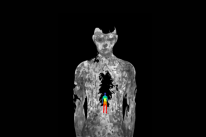
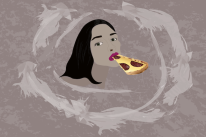


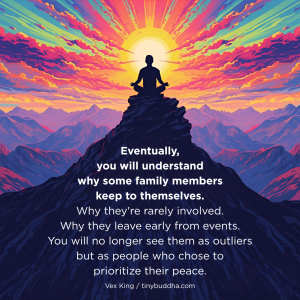




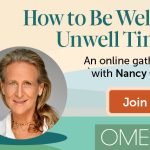
 Though I run this site, it is not mine. It's ours. It's not about me. It's about us. Your stories and your wisdom are just as meaningful as mine.
Though I run this site, it is not mine. It's ours. It's not about me. It's about us. Your stories and your wisdom are just as meaningful as mine.